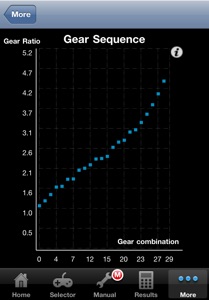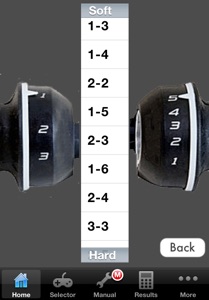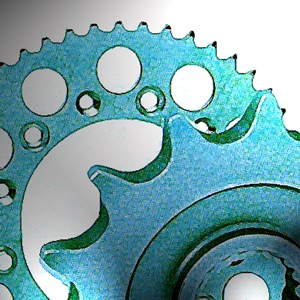

Bicycles today have too many gear combinations for them to be remembered by heart in their sequence from the hardest to the softest. This is an even higher challenge when owning multiple bicycles, each of which meant for different purposes. iBikeGear allows serious cyclists to input, for up to 3 bicycles, the front and rear gear packs chosen from the most diffused versions in the market (596 and 274 models, respectively). Also, individual teeth number can be manually input for custom packs.
iBikeGear automatically calculates the gear ratio for all the possible combinations and ranks them from the softest to the hardest. Additionally, depending on the user settings, sub-optimal combinations due to excessive chain misalignment or to a disproportionally high number of teeth (for the same gear ratio) will be indicated in brackets and removed from the final list.
The final, optimized list of front/rear gear setting is memorized for each bicycle, in order to be promptly recalled and visualized on the screen. Also, a window showing the 'hardness' match among the gear combinations of the 3 bicycles is provided, helping riders to train at the same effort independently of the chosen bike.




KAIROS Srl, Via Malpighi 3, 20129, Milan, Italy. Lab: +39-02-45480568 mobile: +39-347-3657357 Skype: albertominetti iChat: aminetti@me.com
The graph is meant to provide a quick view on the appropriateness of the available gear combinations for a bicycle. Whenever a given gear combination is felt as tiring, the rider decides to replace it with a softer one, and it is advisable to have a number of choices involving a muscular effort not too different from the one just left. Similarly to automobile gears, which have to be equally spaced to ensure 'continuous' acceleration, here the points in the graph need to be located on a smooth curve, as to avoid any abrupt change in the ordinate (vertical axis) value. Many commercial gear packs are already designed as to produce smooth curves in this window. This option is particularly useful when expert riders decide to build custom packs by assembling individual front and rear sprockets.
Before proceeding on 'Optimize', the user needs to input the maximum tolerated amount of chain misalignment, in terms of lateral (left or right) sprocket slots with respect to a chain perfectly aligned. The selector on the left hand side of the page reports, as the maximum value, the highest possible misalignment according to the chosen front and rear sprockets (example: with a triple front chain rings and a 7 sprocket rear pack, the maximum misalignment is 5 slot).
After selecting the maximum allowed tolerance, a click on 'Optimize' will result in the generation of the gear combination sequence, from the softest to the hardest one, as showed in the right hand side of the page. The combinations in brackets indicate that they should be avoided to prevent chain misalignments.
The results from the optimization process can be saved in one of the 3 bicycle-slot, for successive consultation and comparison, by clicking on the relevant button. Before proceeding on saving the optimized sequence, the user needs to input the diameter or the circumference of the rear wheel (in cm or inch). The accuracy of this measurement, which has to include the tire, is crucial to compare the pedalling effort of different gear combinations on the different bikes (see Advance page).

iBikeGear



